Absolute dating
Whenever it is possible to date an artefact or a site to a particular year (or interval of years). This can be made using dendrochronology, carbon-14, or datable objects such as coins.
AIMA
Australasian Institute of Maritime Archaeology
Aircraft
There are plenty of sunken aircraft underwater, many of them from World War Two. Some are just fragments, but others are intact. This area is researched by Steven Carmichael-Timson and Adam Wilson at Sea-Tech Exploration, UK.
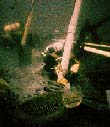 Airlift
Airlift
A wide tube is lowered to the excavation site. Into the lower end of the tube compressed air is pumped from the surface. The air bubbles up and creates a suction. This pulls up water, sand, and small objects. All of this can be sifted on deck. Photo at right by Mary Rose Trust. Detail photo.
Air survey
This search method was used already in the 1930s to search for old ports at the coast off Lebanon. It has also been used in Switzerland and Florida. In the 1990s, the north German coast has been surveyed by a small plane from 150-600 m altitude. Several wrecks were found, photographed and positioned by GPS. Except from shipwrecks, submerged settlements and other structures can be found. This method is suitable for coastal areas with a shallow and flat sand bottom. Thus it works for the south Baltic Sea (flat sand bottom) but not in the north Baltic Sea (rock or clay bottom). Successful work requires bright sunlight over a calm sea with clear water. (Ref. otto.braasch@landshut.org) More info.
Amphora
Large round ceramic container used for transportation and storage of goods. Used from antiquity until the 16th century or so. Used for wine, oil, olives, grain, etc, etc. Amphoras in a shipwreck can often tell the age and nationality of the wreck. More info.
Analysis
Analysis of a find usually involves classification and dating. This is a basis for interpretation.
Anchor types
Archaeology
Knowledge of human life through the study of human antiquities, especially of the prehistoric period (no written sources) and usually by excavation. However, underwater archaeology also includes the historic period (written sources).
Archaeological context
The physical setting, location, and cultural association of artefacts and features within an archaeological site. Artefacts removed from their context lose a lot of their information. See Context.
Archive search
Artefact / Artifact
Any object made or modified by humans.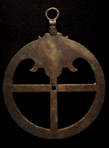
Astrolabe
Instrument used for celestial navigation. A large collection (more than 10) is displayed at the Museu de Marinha in Lisbon. Photo of astrolabe from the Batavia, courtesy Western Australia Maritime Museum. Illustration of usage.
AUV
Autonomous Underwater Vehicles are underwater robots that are not remote controlled and operate with artificial intelligence. Just like ROVs they are used instead of divers for difficult operations, e.g. on great depth. More info.
Avocationals
These are recreational scuba divers and amateur underwater archaeology groups who give invaluable help to
underwater archaeologists. Examples are volunteer unpaid divers during investigations and diving clubs
cooperating with archaeologists and maritime museums.
Local scuba diving clubs often contribute a lot to the official undewater archaeology, contributing
with wreck positions, participating as volunteer divers in official projects, or organising their own
documentation projects. Documenting a wreck on your own can be OK as long as you do not touch anyhing.
Regulations vary from country to country.
Baltic Sea
The world's largest brackish water sea, located in northern Europe. The low
salinity affects not only teredo navalis and shipwrecks, but also all animal life, where the fish are
of different species. The oceans have a salinity exceeding 3%, but the Baltic Sea has a salinity of 0.8% in
the south, 0.3% in the north and 0.6% in average. Through currents there is a constant exchange of salt
water from the Atlantic with brackish water from the Baltic. The heavier salt water stays in the deep,
usually below 40 m depth (in the south) and 80 m depth (in the north). The lighter brackish water is always
nearer surface. Between these layers there is also a constant exchange with the water movements – salt
spreading up, and brackish water and oxygen diffusing down. For reasons unknown, perhaps climatic change,
the Baltic Sea salinity is reducing, and several fish are now endangered.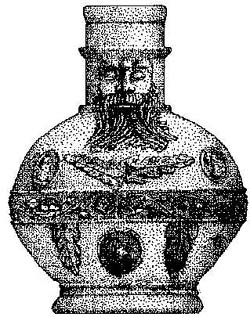
Beardman jug
Common ceramic in the 17th and 18th centuries. May have contained wine or beer. Drawing of a jug from the Vergulde Draeck (1656) drawn by Jeremy Green, courtesy Western Australia Maritime Museum.
Boat grave
A boat grave is a kind of ship burial, where a small boat is used. Examples of boat graves are Neolithic log boat graves, like the St Albans logboat grave. Other examples are planked boats used in Viking Age burials, perhaps they were simply poor man's/woman's versions of the larger ship burials.
Bog finds
Bottles
Brackish water
Mixture of seawater and freshwater. The low salt-rate usually excludes those organisms that eat wood on shipwrecks, e.g. the shipworm Teredo Navalis. Read more about the Baltic Sea.
Bronze
Alloy composed of 90% copper and 10% tin. Highly resistant to corrosion but not as strong as iron or steel.
Bronze Age
The era when bronze was first used but not yet iron. In Minor Asia and the Mediterranean it lasted from c 3300 BC until 1200 BC. But in the Nordic/Scandinavian area it started about 1800-1500 BC and ended ca 500 BC.
Cannon
Cannon finds can identify a shipwreck, but not always. Bronze guns were often taken in battle and reused on new ships. Sometimes the guns could be 100 years old already at the time of sinking. More info.
Carvel
Cenotes
Natural waterfilled holes on the Yucatan peninsula, Mexico. Used as ritual wells. Many of then contain artefacts sacrificed to the Mayan gods. The cenotes are now being investigated. The cenote at the sacred city Chichen Itzá in Yucatan, Mexico, has been investigated since the 1960s.
Ceramics
See pottery.
Children
See kids.
Chronometer
Created by John Harrison, the father of modern navigation. The chronometer is a clock that is accurate enough to calculate the longitude of a ship's position. In 1763 he built such a clock and was later awarded a £20,000 prize for his invention.
Circular search
As well as the line and square search patterns, this is a simple method for divers to search an area of the seabottom. The diver starts at a fixed point on the bottom. Fastens the search line. Swims a circle with the line stretched. For each turn this line must be slackened.
Clay pipes
These tobacco pipes were popular during the 17-19th centuries. They were fragile and had a short life span. Thus they are a good aid in dating maritime finds. More info.
Clinker
Cog, ship type
Commercial activities & archaeology
Can commercial interests and archaeology co-exist? The answer depends on whom you ask. See Ethics, Economy, Selling artefacts, Debate, and Salvage.
Compass
Magnetic instrument used for navigation. Introduced in Europe around 1190 AD. It probably came from China where it had been used several centuries earlier.
Concretion
Stone-like encrusted clump/conglomerate created by the natural elements around an artefact, often rusted iron. If a concretion around an iron object is cracked underwater, black "smoke" pours out. This is not good, because without the protective concretion, the remaining iron is exposed to further rusting. Concretions should never be cracked, just documented. If a decision is made to recover, the entire concretion should be recovered and quickly be placed in a jar of sweetwater, pending further investigation, possibly by X-ray. A concretion sometimes contains the hollow space after an object that has rusted away. Thus it’s important not to crack it. Such a hollow can be casted by filling it with epoxy, saving the object’s original form.
Conservation
Having received an object, the conservator's task usually includes cleaning, documentation and analysis, and finally, stabilisation. Wood and organic material can be stabilised using freeze-drying or PEG. Metal can sometimes be treated with electrolysis. More info.
Context
The careful investigation of objects in situ usually gives far more valuable information, than just the object by itself. An object without provenance (place of origin) has lost its story.
Copper sheathing
Used underwater on wooden ships to repel marine organisms. Compare with lead sheathing. Copper sheathing was first used by the British Royal Navy in 1761. In 1832, George F. Muntz developed a cheaper, more durable alloy of copper and zinc (59-61% copper, 38-40% zinc, and 0.5-1% tin). More info.
Corrosion
Except for gold, metals corrode in sea water. Corroded metals are a special problem. Sometimes iron has disappeared totally, just leaving a cavity inside a concretion, which can be casted (filled with plastic or plaster). Sometimes the metal is still there, but need various conservation treatment. This is described by Donny Hamilton in Methods of Conserving Archaaeological Material from Underwater Sites.
Crannogs
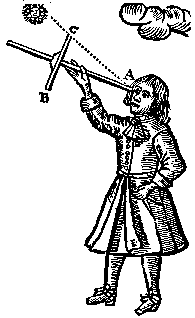 Dwellings built on lakes in Ireland and Scotland. They were constructed on small natural or man-made
islands, in lakes, rivers, or swamps. The remains are often partly submerged. This submerged environment
offers good preservation for organic material. As an example, in Loch Tay (Scotland), 2500 years old butter
has been found. More info.
Dwellings built on lakes in Ireland and Scotland. They were constructed on small natural or man-made
islands, in lakes, rivers, or swamps. The remains are often partly submerged. This submerged environment
offers good preservation for organic material. As an example, in Loch Tay (Scotland), 2500 years old butter
has been found. More info.
Cross staff (Jacob's staff)
Instrument used for celestial navigation. This instrument was eventually replaced by the quadrant, the octant, and the sextant. The drawings are from Practical Navigation by John Sellers (1672), also appearing in Manuskript om navigationens udvikling by Jens Kusk Jensen (Copenhagen 1913, the manuscript is located at the Handels & Søfartsmuseet in Kronborg, Denmark). Photo.
Cultural tourism
As long as wreck divers do not damage a historically valuable wreck, it should remain available for everybody. Unfortunately, some valuable wrecks (at least here in Sweden) have been damaged, resulting in all diving prohibited on those sites. Pity. Cultural tourism with minimal impact should be ideal for everybody. See Look but don't touch.
Dating
Decay
This is also called site formation. In most oceans (except the Baltic Sea and a few other places),
a shipwreck under water deteriorates rapidly during a first stage. This often takes decades for a wooden
ship and about a century for a steel ship (shorter time in shallow water). What remains after that is
usually stable for millennia if it remains covered by sand, sediment, coral, or other encrustions.
A
relatively stable wrecksite is usually in no urgent need of excavation, except for the risk of being
destroyed by unexpected natural causes or human impact. It is often desirable to leave such a site
untouched, saving money for conservation, and saving the site for future archaeologists, that probably
will have better methods. More on
degradation.
Deep sea investigations
Degradation
See Decay.
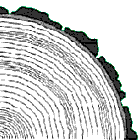 Dendrochronology
(tree-ring dating)
Dendrochronology
(tree-ring dating)
This is a way of dating past events or climatic changes by a comparative study of annual rings (growth rings) in tree trunks. Depending on annual weather changes, the rings are thinner or thicker, creating a fingerprint-like pattern. Reference charts for such patterns have now been created covering more or less the last couple of thousand years. When compared patterns match, each ring corresponds to an exact and known year. This way an old a piece of wood can be dated. To get an exact year from e.g. pieces of a shipwreck, it's necessary to find a piece that includes "surface wood", closest to the bark, else the dating will be approximate. More info.
Destructive archaeology
Most investigation methods in archaeology are destructive. We destroy what we study. Thus it’s important
to –
A: Excavate just as much as necessary. A stable site may be better to leave untouched to coming generations.
They will be happy, and perhaps also possess much finer investigation methods.
B: Document the investigation as thorough as possible. Future analysis may need just those tiny details that
may seem insignificant today.
This is described in Archaeology from the Earth by Sir Mortimer Wheeler (Penguin 1954).
Diving bell
Diving bells (dive bells) are described in Italy already in the 1530s. In the 17th century divers worked in very large bells. In the top was an air pocket, and below was free workspace towards the wreck. Around 1650 several of the Vasa guns were salvaged by the diver Hans Albreckt von Treileben. In the 1690s the concept was improved by Edmond Halley, den English astronomer. And in the 18th century it was further developed by the Swede Mårten Triewalds. Around that time, air barrels could be submerged to the diver.
Dugouts
Ecofact
Object not made by humans, but indicating the presence of humans at a site, e.g. bone, shell and seed. Garbage can be considered ecofact if it is not modified by humans, otherwise the garbage is considered artefact.
Economy
Limited budget and financing is a problem for archaeology. Only a limited number of wrecks or artefacts can be excavated or taken care of. Meanwhile, legislation is needed to protect our heritage against uncontrolled treasure hunting and looting.
Educational
See kids & school and courses.
Ethics
Excavation
Experimental archaeology
Fathom
Traditional unit for depth measurement. Equals 1.8 metres or 6 feet.
Fieldwork opportunity
Excavation and investigation projects are usually quite temporary. So lots of archaeologists, and amateur avocationals, constantly need to look for the next dig. If you look for a fieldwork opportunity, you may try contacting museums, societies, academic departments, authorities. Or Google for archaeological fieldwork opportunities. You may also contact the various replica projects if that's your speciality.
Galvanism
When different metals are in contact with each other, one "eats" the other according to the scheme below,
listing the most durable metal last. The table also reflects the durability of metals immersed in water.
This knowledge is useful for understanding a deteriorated wrecksite, as well as for treating recovered
objects (never mixing metals).
The galvanic series : zinc, iron (cast iron, forged iron, steel), tin, lead, bronze (61-83% copper and the
rest tin), copper, artillery bronze (88% copper, 2% zinc, 10% tin), silver, gold.
Source: IJNA 11.3 (1982) pp 221-231.
GPS
Global Positioning System is a system for navigation by satellite. Navigation satellites continuously send signals. The receiver calculates the position with high accuracy.
Grid
To map and measure a site, and to position individual finds, a large or smaller grid is often placed over the site. Such a grid can be made of aluminium framing or other material. Photo.
High energy site
Wreck site with violent sea movement. This could be a shallow water surf zone, e.g. the wreck site of San Pedro de Alcantara. Along the Florida coast, this condition is reported as deep as 30 metres, destroying shipwrecks and sometimes moving bottom sand.
IJNA
International Journal of Nautical Archaeology, published by the Nautical Archaeological Society four times per year.
INA
Institute of Nautical Archaeology, Texas, USA
Inspection
Simple visual assessment of a reported find. The purpose is to classify the age and type of wreck or find. This can be a desicion-basis for a possible investigation. It can also be part of the actual investigation.
Internet
is an efficient tool for both information and disinformation. Unlike the printed literature and press, the web has no efficient quality control. In the electronic democracy, anybody can write anything. So don't believe everything you read on the web. And if something is incorrect on these pages, please let me know.
Interpretation
Having documented a find (described what you see), the next step in your investigation is to make an interpretation. Now you determine what this object has been and what it has been used for. Sometimes the interpretation is a guesswork. Sometimes you test your theories with a reconstruction.
Investigation underwater
An investigation usually follows a certain procedure.
Iron
If iron artefacts are recovered from seawater, they need to be stored as soon as possible in sweetwater. Old rusted iron exposed to air, starts to disintegrate in 10 minutes.
Iron Age
The era when iron was first used. In Minor Asia and the Mediterranean it was from c 1200 BC until classical antiquity, ie until c 600-300 BC. But in the Nordic/Scandinavian area it was from c 500 BC until the end of the Viking Age (c 1050 AD). Roughly the Nordic Iron Age ended with the introduction of Christianity.
Kids & School
Underwater archaeology can indeed be presented for children and at school. A beautiful book for the youngest (up to 12 or so) is Au fond des mers by Daniel Reyss / Jean-Yves Blot (Gallimard Jeunesse / Octavius aventure 1999, ISBN 2-07-052448-5). Hopefully it will be translated to English and other languages. For the slightly older there seems to be mostly standard literature. Among magazines, good examples are Dig and Arkéo. In Italian, you find the excellent Picchetto l’Archeologo on Youtube. Some of the educational sources on the web are: Schoolnet, PBS Teachersource and Bigchalk. Any other suggestions? Which books would be good introductions at primary or secondary school level? Can TV productions or interactive web sites be "better" than books?
Lake dwellings
Land rise
Lead sheathing
Used underwater on ancient Roman ships to repel marine organisms. This was forgotten during the middle ages. From the 18th century, wooden ships were again sheathed with lead or copper. Photo of lead sheathing in situ, from Angra D wreck, photo by Paulo Monteiro.
Legislation, European
Legislation, international
Lift bag
Convenient tool for recovering heavy artefacts. The rule is: Don’t be above it (it accelerates) and don’t be under it (it may drop objects or flip on surface and crash to bottom). Photo.
Logboats
Look but don't touch
This is what scuba divers/cultural tourists are told regarding old wrecks. This is also what archaeologists do, unless they must salvage something. So, what's the problem with bringing up loose objects? That depends on the particular case. On a historically interesting wreck site I can give these reasons against salvaging artefacts:
- A salvaged artefact loses its context unless carefully documented. The context carries more valuable information than just the artefact.
- Salvage, conservation and storage must be paid for. Most museums are already overloaded with stored artefacts.
- Shipwreck parts in a stable environment (e.g. wreck parts covered by sand, or wooden wrecks in the Baltic Sea) are often best preserved left where they are, and in most cases they will remain accessible to future research.
- Excavation methods improve all the time, so we should leave some sites untouched for future archaeologists.
Looting
This problem is (so far) greater for land archaeology than for underwater archaeology. Every day, poor people in poor countries steal artefacts and ruin archaeological sites. Such objects have lost their precious context and provenance. They are smuggled to richer countries, like Sweden, where I live, and are sold. Sometimes stolen objects end up in museums. It is difficult to stop this, but doing nothing at all would be the worst alternative. Whenever you see a nice object in a museum, or in a private home, why not ask where they got it from. Too often, archaeologists find a site only after it's been looted. A recent example is the Sadana shipwreck. See also Treasure hunting.
Magnetometer
A proton magnetometer is a search tool detecting iron. More info.
Mapping
An underwater site can be mapped in various ways. To position a limited number of spots, fixed datum points may be used for reference. To create a very detailed map a large grid (e.g. aluminium frames) may be placed over the area. These methods are sometimes combined with a photo mosaic.
Maritime archaeology
The archaeology of maritime material culture, e.g. related to shipping or settlements, sometimes underwater, sometimes on land. More info.
Maritime disasters
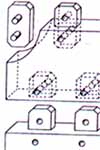 Mortise
and tenon
Mortise
and tenon
During Antiquity, this was a common way to fasten hull planks to each other, edge to edge, by inserting a multitude of plugs into adjoining planks. It was practiced until the end of the Roman Empire, often together with the shell-first method.
Nautical archaeology
Can be explained as maritime archaeology, specialising in maritime activities and technology such as ships, boats and other crafts.
Naval battles
Neolithic Age
This was the last period of the Stone Age, just before the Bronze Age. The people lived in settlements off agriculture and farming. In the Middle East the Neolithic Age lasted ca 9000-3300 BC. In Northern Europe it lasted ca 4000-1800 BC. During late Neolithic Age, some civilisations learnt to use copper, but not yet bronze. Such cultures are called Calcolithic.
Non-vocational divers
See Avocationals.
Octant
Navigation instrument measuring solar and stellar heights. Photos.
Osteology
Bone analysis. Human bones are an important source of scientific evidence about the past.
PEG
Short for polyethylene glycol. A conservation method for old waterlogged wood. Broken down cells are filled with this solution. Thus PEG replaces cellulose that has deteriorated from the wood. Without this treatment the wood would shrink and crack when dried. More info.
Pile dwellings
Prehistoric lake or riverside settlements where a substantial part of the buildings were built on poles, in or near the water. The remains of such settlements have been found underwater. It's often difficult to say whether the submersion is a result of raising sea level or the buildings actually were built standing in the water. Thus some pile dwellings may originally have been built on shore, later submerged, and today we find the remaining house poles underwater. More info.
Photo mosaic
To make an overall image of a site with limited visibility, a series of closer-range photos is made, and later assembled. Such photos can be made from e.g. a fixed grid frame. Example mosaic, from the Gellen wreck, Germany, made by Klaus Andrews, Hamburg.
Plotter / Video plotter
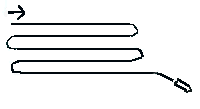 This
is a computer monitor that displays the path of the search ship. It gets the position from a connected GPS
receiver. Thanks to GPS with a plotter, you can use side-scan-sonar efficiently. Ideally, a search pattern
may look like this drawing. Search pattern from Sture Hultquist.
This
is a computer monitor that displays the path of the search ship. It gets the position from a connected GPS
receiver. Thanks to GPS with a plotter, you can use side-scan-sonar efficiently. Ideally, a search pattern
may look like this drawing. Search pattern from Sture Hultquist.
Polyethylene glycol
See PEG.
Popular science
The movie Jurassic Park may have done more than anything else in recent years for palaeontology. Likewise, underwater archaeology can benefit from being popularised. A boosted public interest may in the end give more resources for actual research.
Pottery
Just like in land archaeology, pottery can easily be typologically dated, and is a useful aid to date a shipwreck. Examples are the amphora, beardman jug, and terra sigillata.
Prehistory
The time before which there are no historical records, either in writing or by oral tradition. Which time that is depends on where you are. Mesopotamia and Egypt had writing already ca 3000 BC, while other civilizations relied on just oral tradition until the 19th century.
Procedure in underwater investigation
The procedure is similar to land archaeology. Very simplified it goes like this: 1.
Research, 2. Reconnaissance, 3. Planning,
4. Pre-disturbance survey & mapping, 5. Excavation &
documentation, 6. Conservation, 7. Analysis, 8.
Interpretation & reconstruction, 9.
Publication, 10. Re-assessment & criticism.
Sometimes the exact site to be excavated is found during the reconnaissance or survey. Other times a
site or wreck location is already reported and known, perhaps briefly inspected.
Compare with the San Pedro fieldwork procedures or the
NAS training.
Provenance
Origin, location, arrangement or relationship of an object or a collection of objects.
Publication
A report is considered published once it can be referred to in libraries or otherwise (by author, title, year, ISBN number etc). Usually it is printed on paper as part of an academic publication, in a book, magazine or newspaper article. Sometimes it's published only on CD-ROM, which can be referred to just like a book. A report may also be published only on the web (like several articles on this site). One problem with web publications is that referrals may be unreliable, since web addresses sometimes change. If you refer to a web article, just the web address (URL) isn't enough. You should also include the author, the title, and if possible the publication date.
Purpose
What's the point of archaeology? Why spend resources on all this anyway? Well, perhaps knowing our past helps us knowing ourselves. Or, as Sir Winston Churchill put it at a speech in Copenhagen in 1950: "No amount of technical knowledge can replace the comprehension of the humanities or the study of history and philosophy."
Quarter rudder
A.k.a. side rudder. Ships of antiquity had two side rudders. Nordic ships had one, placed on the starboard (right) side. During the middle ages all European ships slowly changed to using one stern rudder. A rare transitional case of both types on one ship is the Les Sorres X wreck.
Radiocarbon analysis
This dating method is based on the natural decay of the Carbon-14 isotope (written 14C or C14). This unstable isotope is accumulated during the lifetime of all organisms. When they die, the C14 decay starts. Thus, the time since death can be measured on samples of organic material, e.g. wood. A problem is that the natural rate of radiocarbon has not been constant over the centuries. This error can often be corrected by calibration. The calibrated age is often 5-10% greater than the uncalibrated age. Explained in Keith Branigan's Archaeology Explained (Duckworth 1973, 1988). More info.
Ram
 The bow of ancient warships had a ram, a rostrum, in the waterline. In that way an enemy ship could
be rammed and sunk without having to board and engage in dangerous close combat. The best preserved ram is
the 2.25 m long and 465 kg heavy Athlit ram, found in 1980, displayed at the National Maritime Museum,
Haifa, Israel. Inside the bronze ram some of the ship's wood is still preserved. Similar rams were once
displayed at the Actium Naval Monument in
Nikopolis as well as on Forum Romanum in Rome.
The bow of ancient warships had a ram, a rostrum, in the waterline. In that way an enemy ship could
be rammed and sunk without having to board and engage in dangerous close combat. The best preserved ram is
the 2.25 m long and 465 kg heavy Athlit ram, found in 1980, displayed at the National Maritime Museum,
Haifa, Israel. Inside the bronze ram some of the ship's wood is still preserved. Similar rams were once
displayed at the Actium Naval Monument in
Nikopolis as well as on Forum Romanum in Rome.
The last time a ram was used in battle was at Lissa off the Dalmatian coast in 1866. The Austrian
Ferdinand Max rammed the Italian ship Re d'Italia, which quickly sank with hundreds of sailors.
Both warships were rather traditional wooden ships with sail and steam engines. Many warships still carried
rams around World War I. Source: E.L. Cornwell (ed), An Illustrated History of Ships (London 1979).
Photo courtesy prof. Elisha Linder. Photo of ram from replica ship
Olympias, by J.S. Illsley.
Reburial
Sometimes the best way of conservation is reburial of the site after investigation. Examples are BZN 10, Fredricus and the Madrague de Giens wreck.
Reconstruction
A reconstruction can be a way to test a hypothesis or an interpretation. A reconstruction of a ship can be in the form or a reduced-scale model or a computer model, or a full-scale reconstruction. Historical reenactments are also a form of reconstruction.
Replicas
Relative dating
As opposed to absolute dating, this gives no date, but instead a relative date (earlier/later) compared with other finds. This can be the case using stratigraphy.
Remote sensing
See magnetometer and side scan sonar.
Research
Riverine archaeology
(French: archéologie fluviale) Maritime archaeology, specialising in the study of artefacts of early river traffic, such finds may often consist of e.g. ancient barrages (pole palisades) or logboats. Example from historic times: Ice Boats of the Leeds and Liverpool Canal, by Albert Fischer. Another example is the Excavations in Saône River, France.
Rock art
![]() Nordic/Scandinavian
Bronze Age rock carvings often depict boats or ships. What those boats looked like in reality nobody knows.
Apparently they had oars but not sails. Perhaps they were similar to the
Hjortspring boat. According to Swedish archaeologist Li Winter, there is a
strong similarity between Swedish Bronze Age carved ship images and the
Greek ships of that time, indicating possible contacts.
Nordic/Scandinavian
Bronze Age rock carvings often depict boats or ships. What those boats looked like in reality nobody knows.
Apparently they had oars but not sails. Perhaps they were similar to the
Hjortspring boat. According to Swedish archaeologist Li Winter, there is a
strong similarity between Swedish Bronze Age carved ship images and the
Greek ships of that time, indicating possible contacts.
ROV
Remote Operated Vehicles are remote controlled underwater robots used instead of divers for difficult operations, e.g. on great depth. More info.
Sacrifice offerings
Presumably ancient lakes and moors were used for sacrifice. In recent times many finds have been made in bogs and moss: deliberately bent swords, logboats, other boats and executed people. Examples are the Nydam boats and the Mexican cenotes.
Salvage
Commercial salvage of objects from relatively young shipwrecks, e.g. Titanic, may be justified by the fact that the ship is deteriorating, i.e. the wrecksite is not yet stable. Reasons against salvaging old wrecksites are that they are often stable (thus no hurry) and they are often historically or archaeologically valuable (information may be lost). More info on Salvage and Recovery.
Sea-level changes
See Land rise or Submerged structures.
Scuba
Short for Self-Contained Underwater Breathing Apparatus, the most common and inexpensive
diving system. The diver usually breathes compressed air from one or two tanks
carried on the back. Scuba divers are useful down to ca 40 m depth for e.g. searching, investigation,
documentation and recovery/salvage.
Volunteer scuba divers are often a great help for the official
diving archaeologists.
Scupper
An opening in the base of a ship's gunwale, that allows water to drain off the deck.
Search pattern
During scuba diving, see circular search – using GPS, see plotter.
Selling artefacts
Artefacts are often sold on the open market, sometimes from over-stocked museums (not considered ethically acceptable at museums in many countries), and sometimes by private collectors and diving trophy hunters. This might be viewed as non-problematic as long as excavation and documentation have been properly carried out. However, it is not ethically acceptable to plan an excavation with the aim of selling salvaged items and making a profit. A pure profit motive often compromises excavation and documentation. See Ethics.
Sewn boats
A sewn boat is tied together rather than using pegs, nails or bolts. There are two categories:
A – Plank boats. An early find is from the British North Ferriby
 (c 1700-1500 BC). Later finds include some early Greek ships. The oldest Nordic find is the Hjortspring boat
in Denmark (c 300 BC). In Finland, Russia, Karelia and Estonia this tradition has existed until recent
times.
(c 1700-1500 BC). Later finds include some early Greek ships. The oldest Nordic find is the Hjortspring boat
in Denmark (c 300 BC). In Finland, Russia, Karelia and Estonia this tradition has existed until recent
times.
B – Skin boats. One example is the Irish coracle, that was made until the 20th century.
Ancient skin boats were
probably only made to a limited extent. A modern example is the foldable kayaks made by
Klepper and other brands.
Link.
Sextant
Navigation instrument measuring solar and stellar heights. Used on land since 16th century – the naval version was developed in 1757 by Captain John Campbell. The name refers to a sixth of a circumference – 60°. Thus the sextant can measure angles to 120°. The octant operates in a similar way but measures smaller angles.
Shell-first
In wooden shipbuilding, first the hull planks are assembled, then the frames are inserted. This was the normal method in Antiquity, and in Northern Europe, it's still practised for clinker-built boats.
Ship burial
A ship burial or boat grave is a burial in which a ship or boat is used either as a container for the dead and for grave goods, or as part of the actual grave goods. If the ship is really small, it's called a boat grave. Examples of ship burials: Abydos, Khufu, Sutton Hoo, Vendel, Valsgärde, Ladby, Oseberg, and Gokstad ships.
Ship setting
Burial decorated by a stone setting in the shape of a symbolic ship, but not containing an actual ship. Swedish examples are Anundshög and Ales stenar.
Ship types
Shipworm
(latin: teredo navalis) This little animal eats wood. It only resides in salt water. Thus wooden wrecks in the Baltic Sea and sweetwater lakes are spared. More on degradation.
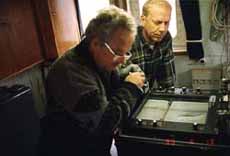 Side
scan sonar
Side
scan sonar
This is a sonar that can look sideways. This can be compared with a radar, but uses simple sound echoes. The beeps are sent from and received to a fish that is pulled after the search ship. The signals are sent in a wide angular pattern down to the bottom. Thus each pulse lets us "see" a narrow strip below and to the sides. As the fish advances, an image is displayed on a monitor or a paper plotter (photo). More info.
Site formation
See decay.
Skeleton-first
In wooden shipbuilding, first the keel, stem and frames ate raised. Then the hull planks ate bolted on. This method is common from the Middle Age and on.
Skin boats
See sewn boats.
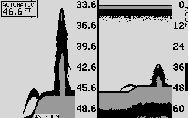 Sonar
Sonar
Sonar (SOund NAvigation and Ranging) is a simple way to detect wrecks. It uses sound pulses/echoes, it is inexpensive and can be fitted in small boats. Modern systems can be combined with GPS. A split-screen function allows for detail studies while keeping the overview. Some sonars are sediment-penetrating, revealing objects below the seabottom. Image from SMAS of a wreck.
SSBA
Stabilisation
The final stage of conservation.
Stern
The rear of a ship where the rudder is located.
Stratigraphy
The study of layers, sequentially deposited over time. This is very helpful for land archaeology. Under water it can also be useful, but it's more complicated and often confusing because of current and sea movement. This is explained in: Archaeology Underwater – the NAS Guide to Principles and Practice (1992) and Keith Branigan's Archaeology Explained (Duckworth 1973, 1988).
Submarines
Submerged site archaeology
Maritime archaeology specialising in the study of inundated sites (terrestrial sites which have been submerged due to land subsidence or rising sea levels). More info.
Sunken cities
Teredo navalis
Terminus ante quem
Latin: "limit before which". Used in relative dating, when something can be dated before a certain year. This may be concluded from stratigraphy. If for example wreck A is laying under wreck B (dated), then wreck A is older than the year of wreck B.
Terminus post quem
Latin: "limit after which". Used in relative dating, when something can be dated after a certain year. This may be the case if datable coins are found in an old shipwreck.
Thermoluminiscence
Dating method based on the fact that clay and a few other inorganic materials absorb small amounts of nuclear energy from natural radiation. The dating involves measuring the amount of radiation absorbed by a ceramic since it was last fired. This method is mainly used for dating prehistoric objects. Ref. William R. Biers: Art Artefacts and Chronology in Classical Archaeology (Routledge 1992)
Time capsule
A well preserved find in its original context can be considered a time capsule. If carefully investigated it can tell us a story, as if people from times past were talking to us.
Trawler fishing
Increasing trawler fishing threatens to destroy many shipwrecks.
Treasure hunting
This usually means commercial search for and exploitation of economically valuable items in historical wrecks. If such treasure is salvaged with no archaeological documentation, in worst case looted, unique information is ruined for ever. More info.
Trireme, ancient warship
Underwater archaeology
Strictly, this means archaeology under water, which is the main discipline of maritime archaeology. However, the term underwater archaeology is often used in a wider sense, also covering maritime and nautical archaeology, not necessarily under water. More info.
Underwater cultural heritage
Underwater parks
Those are sites that are made into underwater museums with on-site signs for visiting underwater tourists. Examples are Kronprins Gustav Adolf, Caesarea, San Pedro, Urca de Lima and possibly Duart Point wreck.
Viking Age
The last period of the Nordic Iron Age, lasting roughly 800-1050 AD.
 VOC
VOC
Verenigde Oostindische Compagnie (Dutch East-India Company), founded in 1602.
Water dredge
This is similar to an airlift. But it is pumped with water rather than air. It can operate in more shallow water than the airlift.
Water saturated sites
Swamps, marshes, bogs and other wetland sites created as a result of changes in the water table due either to natural or human changes to the environment. More info.
Wetland archaeology
Zebra mussels
Increased activity of this organism seems to threaten shipwrecks in the North American Great Lakes.
 Back to Nordic Underwater Archaeology
Back to Nordic Underwater Archaeology